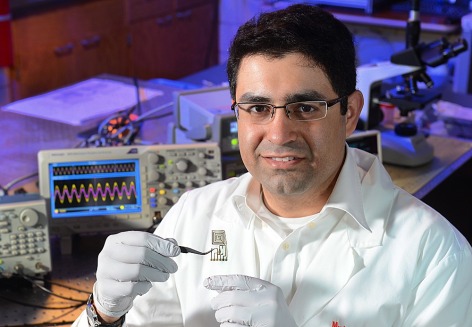A group of researchers out of Iowa State University have published the early details into their groundbreaking study on transient electronics, or technologies that can melt away when a trigger is activated. Should there be continued development in this field, their studies may serve as the foundations for a whole new type of technology.

Led by materials scientist and mechanical engineer Reza Montazami (pictured above), the team created a type of electronic that features materials made of special polymers possessing the ability to quickly and completely melt away when a trigger is activated.
This degradable polymer composite is used as a platform for electronic components and when the degradation process is activated, the user can precisely control the material’s rate of “melt.”
“You don’t expect your cell phone to dissolve someday, right?” said Montazami, who is also an assistant professor of mechanical engineering at Iowa State University. “The resistors, capacitors, and electronics, you don’t expect everything to dissolve in such a manner that there’s no trace of it.”
To support his point, take these examples into consideration: A medical device might one day be able to melt away inside a person’s body after its job is done. A military device could collect data and send it to headquarters before dissolving on the spot, leaving behind no trace of there having ever been an intelligence mission in the area. Environmental sensors could be placed all throughout natural areas for monitoring purposes, and then wash away when there’s rain, or the tide comes in.
It’s a fascinating form of new technology, and something that clearly opens up the door to a lot of new possibilities. To demonstrate its potential, Reza recorded a video of a blue LED mounted on a clear polymer composite base, with its electrical leads embedded inside the actual material. When a drop of water is applied, the base and wiring begin to dissolve. After a few moments, the light goes out. A second drop of water is applied, and whatever’s left completely melts away.
Beyond LEDs, the research team has also developed and tested transient resistors and capacitors. They’re now focusing on lighting and transistor technologies.
If, say, you were to lose your credit card, this technology might one day give you the ability to have it self-destruct, Montazami suggests, adding that it could also be programmed to degrade over certain times and temperatures when stored with food. When the sensors stop working, the food is no longer fresh.
The team’s work was published under the title “Study of Physically Transient Insulating Materials as a Potential Platform for Transient Electronics and Bioelectronics” and has just been published online by the journal Advanced Functional Materials . It is available for download (for registered users).
The team also presented some of its findings at the recent meeting of the American Chemical Society.
Story via: iastate.edu
Advertisement
Learn more about Electronic Products Magazine





